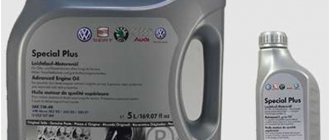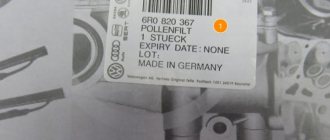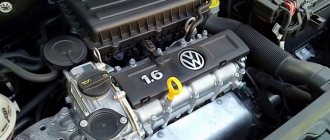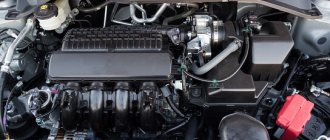The engine is the most important component of a car and requires constant monitoring and care, and one of the main maintenance items is replacing old motor lubricant with new one. Thanks to it, all parts of the power unit are covered with a protective film, which protects them from wear and corrosion. In addition, the lubricant reduces the operating temperature and cleans the inside of the engine from emerging dirt and all kinds of impurities. Using various additives, manufacturers change not only the viscosity of motor oil, but also its various characteristics. In this article we will try to figure out what kind of oil should be poured into the Polo sedan engine and why.
What kind of oil is poured into VW directly at the factory and what kind can be purchased for topping up
High-quality motor oil will make the operation of your car’s engine not only stable, but also more durable, so you should take its purchase very seriously. Today, the market for fuels and lubricants has become so diverse that it is sometimes quite difficult to make a choice. However, if it is necessary to change the oil of a Polo sedan, then you should take into account the recommendations of the manufacturer of this car brand.
German manufacturers have developed four types of oils with the required characteristics for the VW Polo Sedan. These include the following types:
- VW501 01;
- VW502 00;
- VW503 00;
- VW504 00.
These designations correspond to the classification of motor oils according to the ACEAA2 or A3 standard. It should be clarified that the ACEAA classification includes motor oils designed for gasoline engines. Oil class A2 is represented by lubricants that have normal performance properties, as well as standard replacement intervals. Class A3 is represented by liquids that have high performance characteristics that can be used for a longer period of time without replacement. Most often they are used as an all-season lubricant with low viscosity. To minimize possible risks, Volkswagen recommends using only original fluid in its cars. If it is not possible to purchase such oil, you can use any other oil that meets the specifications and tolerances for topping up.
Regulations
To choose the right oil, you need to act step by step and observe all important parameters, including performance indicators. For example, you need to know when to replace consumables. For this, the manufacturer has developed a replacement schedule, which for the VW Polo Sedan is about 20 thousand kilometers.
This is a conditional indicator that can be changed at the insistence of the dealership, or on the initiative of the owner himself (with self-service). In the latter case, changing the oil is much more difficult, but it is a very educational and economical procedure that does not take much time. It will have to be carried out as often as possible if the machine is operated in unstable climatic zones and is subjected to high loads.
After all, under the influence of negative factors, the oil must be changed in advance so that it does not have time to lose its properties. Due to difficult conditions, the regulations can be reduced to 10 thousand kilometers. In addition, rapid oil wear is affected by high speed, driving on light off-road conditions, including dusty roads, constant temperature changes, sudden maneuvers and even traffic violations.
In such cases, you must be prepared to change the oil earlier than required by the regulations. But for this it is important to know several factors.
What should be the viscosity of engine oil according to SAE for VW Polo?
Most often, all-season lubricants that have the required characteristics are used. All-season has a double indicator, separated by the English letter “W”, indicating the word Winter, “Winter”. The first value indicates the low-temperature range of the lubricant, and the second indicates the high-temperature viscosity. As for low temperatures, the indicators are as follows:
- 0W— intended for operation at ambient temperatures down to -35˚С;
- 5W— designed for operation at temperatures down to -30˚С;
- 10W—allows operation at temperatures down to -25˚С;
- 15W—allows operation at temperatures down to -20˚С;
- 20W— designed to operate at temperatures reaching -15˚С.
As for the second indicator, it cannot be described so simply, since it represents a certain combined value of the minimum and maximum viscosity. 100 and 150˚С were taken as operating temperatures. The higher the indicator, the higher the viscosity value at high temperatures the engine oil will have. Based on the above, it should be noted that changing the Volkswagen Polo Sedan oil should be carried out with fluids that have the following viscosity according to the SAE standard:
- 5W-30;
- 5W-40.
Oil parameters
Naturally, for Volkswagen Polo it is better to select oil from a well-known manufacturer. Brands with a dubious reputation should be immediately avoided. In order not to get confused in the choice, you must proceed from the recommended parameters developed by the Volkswagen concern itself. For example, first of all, one must proceed from the viscosity characteristics of SAE 5W-40 and 5W-30, as well as the international standards ACEA A2 and ACEA A3. In addition, you need to pay attention to compliance with markings 501 01, 502 00 and 503 00.
The original oil, as well as its analogues, have these parameters. To date, the production of analogues has been established in Germany, Russia, Romania, Moldova, China and other countries. The quality of these oils has recently become equal to more expensive original oils.
Based on this, the obvious choice is in favor of an analogue oil. Although many still prefer the original product.
Among the best manufacturers of motor oils for Volkswagen Polo are the brands Castrol, Mobile, Lukoil, Elf, Kixx and other well-known companies with a good reputation. Also, owners often prefer Shell Helix Ultra motor oil.
Which engine oil is suitable for VW Polo sedan?
- Among the wide variety of lubricants that fill the domestic market, choosing the most suitable product can be quite difficult. Therefore, when choosing, you should adhere to the following simple rules:
- Do not under any circumstances purchase products from an unknown manufacturer that are attractive for their low cost. Often these savings result in expensive repairs; Don’t be lazy to arm yourself with the necessary information on this topic, and also familiarize yourself with what oils Volkswagen car owners use.
If you have the Internet, this is quite simple to do - enter the query in a search engine - Volkswagen Polo engine oil change - and get acquainted with the search results. The following motor fluids may be suitable as an adequate replacement: Liqui Moly Synthoil HighTech; VAG SpecialPlus.
Both of these lubricants are classified according to the SAE standard - 5W-40.
Stages of replacing lubricant Volkswagen Polo Sedan
The replacement on this car is standard; the waste is drained, the oil filter is changed and new oil is added. But there are some nuances, depending on the installed engine. Which relate to the location of the filter, as well as some small details.
This model is very popular not only here, but also abroad, although there it is produced under a different name:
- Volkswagen Polo Sedan;
- Volkswagen Vento.
In our country, petrol versions with a naturally-aspirated 1.6-liter MPI engine have gained popularity. As well as turbocharged TSI 1.4 liter models. In the instructions, we will analyze the correct replacement with our own hands, using the Polo Sedan 1.6 version. We will consider 110 hp engines. CWVA, as well as 105 hp. CFNA.
Draining waste fluid
Draining the used engine fluid is performed on a warm engine. This is due to the fact that heated oil is more liquid. This makes it easier for it to leak out of the thin channels of the lubrication system.
Before starting the procedure, we prepare tools, empty containers for processing, as well as new liquids for subsequent filling. To get to the drain plug located on the engine sump, you must remove the protection, if installed. Standard protection is secured with 4 bolts 13 or 17, as well as 4 screws for Torx T25.
VW Polo Sedan 1.6 105 hp (CFNA)
Let's get down to the drain itself:
- We lift the hood, find the filler neck there, and unscrew the plug (Fig. 1).
oil filler neck - Right there, under the hood, there is an oil filter. It must be unscrewed correctly, since there is a generator underneath it, which should not be filled with oil. Using a puller, loosen the filter, but do not unscrew it completely. Thus, the valve opens and the oil contained in it begins to flow into the pan (Fig. 2).
Fig.2 Oil filter - After 1-2 minutes, put a rag around it, just in case, and unscrew the filter completely. In this case, you should pay attention to the threaded bushing; when unscrewing the oil filter, it can also come out. In this case, screw it back until it stops, by hand (Fig. 3).
Fig.3 Threaded bushing - Now we go down under the car and place a waste container in the drainage area. You can use a cut canister or an old bucket.
- We unscrew the drain plug with a wrench or a socket. On this car, the plug can be 18 or 19 (Fig. 4).
Fig.4 Drain plug - On some engines, the drain plug on the pan is not located at the lowest point, so there is still about 150-250 milliliters of waste remaining in it. To remove them, you can use a rubber bulb or a syringe with a hose attached to it (Fig. 5).
Fig.5 Pumping out residues with a syringe
VW Polo Sedan 1.6 110 hp (CWVA)
We begin the draining procedure:
- Raise the hood, then find the filler neck on the engine and unscrew the plug (Fig. 6).
Fig.6 Oil filler neck - Now we go down under the car and place a waste container in the drainage area. You can use a cut canister or an old bucket.
- We unscrew the drain plug with a wrench or a 18 or 19 socket, depending on its type (Fig. 7).
Fig.7 Drain plug - Now you need to remove the old oil filter. This can be done from above, from the engine compartment (Fig. 8).
Fig.8 Oil filter on top - The filter is clearly visible from above, but unscrewing it is not so convenient, so we do it from below. Access is very good, nothing interferes (Fig. 9).
Fig.9 Oil filter from below - On this engine the drain plug is also located, not at the lowest point. Therefore, you can use a syringe with a tube. To pump out the remaining waste, as shown in Figure 5.
To unscrew the filter element, it is advisable to have a special puller. If it is not available, you can try to unscrew the filter using improvised means. In this case, you can use, for example, an old alternator belt, a regular belt, a bicycle chain or a simple screwdriver.
Unscrewing the oil filter using improvised means
Using this method, you can drain the maximum amount of used oil, after which you can proceed to further actions. The main thing is not to forget, everything that we unscrewed must be put back in place.
Flushing the lubrication system
Flushing the engine on a Volkswagen Polo Sedan should be carried out only in exceptional cases, which include:
- Purchasing a used car when you cannot know about the quality, as well as the regularity of lubricant replacements.
- During operation, the service replacement interval was repeatedly exceeded.
- Engine operation with constant frequent overheating, which contributes to coking and other deposits.
- In cases of switching to another type, for example from synthetics to semi-synthetics.
There are several types of flushes for the Polo Sedan engine:
- Five- or seven-minute, capable of cleaning even the most difficult deposits. They must be used very carefully and strictly follow the instructions printed on the packaging. It is recommended to use them only when absolutely necessary. Since there is a high probability of causing premature wear of the sealing seals. And also clog the oil channels with particles of washed away carbon deposits.
- Special compounds that are added to the oil several hundred kilometers before the expected change. They are more gentle, but there is also a possibility of clogging of the oil channels.
- Flushing oil is the most gentle method of cleaning the engine from the inside. This composition is poured after draining the waste, the engine runs for 15-20 minutes, after which the liquid with deposits is drained. The absence of aggressive additives in the wash composition gently cleans the engine, but is not able to remove heavy contaminants.
- Regular oil that you are going to use when changing. This method is not so popular due to its high price.
Before washing the Polo Sedan, you should weigh all the pros and cons. And also understand that it will not be possible to completely drain the liquid. Some of it will remain in the channels, which will then mix with the new oil.
Installing a filter, filling in new engine fluid
If the lubrication system of the Volkswagen Polo Sedan is sealed and does not require repair work to eliminate leaks, you can proceed to adding fresh engine oil. In addition to the oil itself, to replace it we need a new drain plug, as well as an oil filter. This is what the instruction manual says.
Therefore, for the 1.6 105 hp engine (CFNA) we purchase a bolt with VAG part number N 908 132 02 (N90813202). This bolt already comes with a sealing washer and is designed specifically for use on aluminum pallets. The original oil filter comes with the VAG part number 03C 115 561 H (03C115561H).
Consumables for 1.6 105 hp (CFNA)
For a 110 hp engine (CWVA), you need a bolt VAG N 902 889 01 (N90288901), as well as a gasket-washer for it, the original one is white VAG N 013 81 57 (N0138157). The filter has an article number that is VAG 04E 115 561H (04E115561H).
Consumables for 1.6 110 hp (CWVA)
When everything is ready, let's move on to the bay:
- Replace the drain plug and replace it with a new one if necessary.
- We wipe the seat under the oil filter.
- We twist it and put it in place. Pre-lubricate the rubber sealing ring with fresh oil.
- Pour new oil into the filler neck.
- We check the level on the dipstick; it should be between the MIN and MAX marks.
- We start the engine, let it run for 10-15 seconds, then turn it off.
- After 5 minutes, check the level with a dipstick and top up if necessary.
There are several opinions regarding replacing the oil filter. Some car owners advise filling it with new oil before installation. However, in the official instruction manual for the Volkswagen Polo. And also in information from well-known filter manufacturers, it is recommended to simply lubricate the O-ring.
Resetting the interservice oil change counter
When changing the engine oil yourself, there is a need to reset the service interval, which is displayed on the instrument panel.
For Polo Sedan cars, you must do the following:
- On the instrument panel, press the right “0.0/SET” button.
- Continuing to hold the button, turn on the ignition.
- Release the right button and immediately press the left one.
After passing these points, the service interval will be reset and information until the next maintenance will appear on the meter.
Original engine oil for VW Polo sedan cars
Changing VW Polo oil or topping it up before the first maintenance should be done with the same product that is filled in at the Volkswagen factory. The manufacturer uses LongLife 3 VW 5W30 G 052195M4 motor lubricant, which has VW 502 00 approval.
Be that as it may, for the first time you will have to fork out money and buy the original. Subsequent replacements can be carried out using synthetic oils that have approval from VW 502 00 to VW 505 00. As the manufacturer itself states, lubricant with approval 502 00 is used in engines with a shorter replacement interval, and 504 00 with an increased interval. Thanks to modern additives, 504 00 has better qualities, which has contributed to an increase in service life. If the car is operated in difficult conditions and with fuel of constantly changing quality, it is recommended to use a shortened interval between replacements. For this purpose, option 502 00 would be more acceptable. Difficult conditions include using a car in urban conditions, where downtime in traffic jams, as well as traveling short distances, is not excluded. All this affects the rapid aging of motor lubricant due to increased wear, so drivers are simply forced to replace it after a minimum mileage. However, oil with specification 504 00 has higher flushing properties and is not as susceptible to various oxidation processes. In addition, it quite effectively combats all kinds of deposits that are a consequence of the combustion of any type of fuel. Which lubricant to choose for your car is the right of every motorist, however, you should strictly adhere to the regulations established for a particular region (for cold regions, the next replacement is made after a run of 15,000 km or a year after the previous replacement).
How to check the condition of the oil
To make sure that the oil has become unusable, you need to pay attention to the color, smell and composition of the oil. For example, with high mileage, the fluid may change color from clear to dark brown. As for the smell, the oil may smell burnt and this is one of the signs of mechanical wear. The second, more serious sign is the presence of metal shavings in the oil, as well as mud deposits. In such cases, it is necessary to urgently change the oil. This is the only way to prevent premature wear of engine components, and thereby avoid major repairs of the internal combustion engine.
Changing the oil in a VW Polo car engine
Changing motor lubricant is not such a complicated operation, so to save time and money it can be done at home. Currently, there is a huge amount of textual information and video materials on the Internet, which you should first read carefully. After this, you should establish the order in which each procedure is performed and follow it flawlessly. In this case, you will protect yourself from making any mistakes.
How to choose an analogue
The choice of oil change for Volkswagen Polo is made in accordance with the requirements of the plant.
VAG Specifications
For car models manufactured before 2001, the company recommends using VW 500.00 mixtures. Due to the obsolescence of the standard, it is allowed to use more recent certificates or a group of oils that comply with ACEA A1 / B1. Factory approval applies to naturally aspirated engines without aftertreatment systems.
Polo cars produced after this period (2010-2015 and later) must be filled with such mixtures.
- 501.01 - support for power plants with direct fuel injection, regardless of the fuel consumed.
- 502.00 is a more complex version of the first standard. ACEA A3/B3 compliant.
- 503.00 - works where light turbines are installed and there are no particulate filters. Improved compatibility with extended service intervals.
- 504.00 - the standard is relevant for all power plants with exhaust gas treatment systems, a turbocharger or direct injection. The duration of one section is 30,000 km.
The basis
The Volkswagen Polo uses all three types of lubricants available in 2022.
Mineralka
Operation is relevant for Volkswagen Polo cars manufactured before 2000. Lubrication is produced by processing sulfur oil. It has minimal protective properties and a moderate service life. The advantage is the affordable cost.
Semi-synthetics
The adapter link is mainly used in all generations of engines. Old Volkswagen Polo internal combustion engines can be refilled in any conditions. New engines allow you to fill half of the artificial fluid only with high mileage.
As for the protective properties, all parameters are at an average level.
Synthetics
Advanced engineering. Oil is produced using natural gas synthesis technology to produce complex hydrocarbons. This guarantees the absence of harmful impurities and, as a result, excellent protection of internal components from premature wear.
The mixtures are bottled in new Volkswagen Polo cars.
Viscosity
When it comes to lubricant fluidity, Polo engines are not fussy. Viscosity is determined by the climatic conditions in which the machine is used individually. The SAE J300 standard temperature chart is used as a reference tolerance.
Tools used
Before changing the engine fluid, you should stock up on all the necessary tools and items.
The following items should be added to their list:
- the required amount of new oil, which should still remain for subsequent toppings;
- new oil filter (the old one must also be replaced). If you want to purchase the original model, it will have the following number - 03C115561H;
- new plug for the oil pan. This item may not be needed, but should be on hand just in case;
- engine flushing fluid; container for draining waste;
- open-end wrench set to “18”;
- polygonal star key;
- a strap wrench designed to remove the old oil filter; a small amount of clean rags.
In addition, it is advisable to have an inspection pit or overpass at your disposal in order to gain free access to the bottom of the car.
Amount of oils and fluids volkswagen polo | car breakdowns
Volkswagen Polo is a legendary car. For forty years, five generations of the brand have been delighting its owners with reliable and high-quality service, making life more comfortable and beautiful. But this merit is not only of the manufacturer; the role of the drivers is also great. They carry out maintenance in a timely manner, which has a positive effect on its performance.
Replacing consumables
During the operation of the machine, consumables age and lose their properties, so they need to be replaced. For Volkswagen Polo, the manufacturer recommends that it be carried out once a year or when the mileage is 15 thousand km.
In practice, these periods can be reduced to 10 thousand km. Especially in cases where the car is often stuck in traffic jams and idling. Since the lubricant quickly becomes unusable.
Experts recommend
Below is a table containing all the information that relates to this issue. It specifies parts, systems, quantities and features of consumables.
| Filling/lubrication point | Filling volume, liters | Name of oil/liquid | |||
| Fuel tank | 55 | AI-92 AI-95 | |||
| Engine | Volume 1.6 l | 105 hp | 3,6 | API SL (ILSAC GF-III) VW 502 000 | |
| 86 hp | 4 | ||||
| 110 hp | 3,6 | ||||
| Volume 1.4 l | 3,2 | SAE10W-30 Low temperature areas: SAE 5W-30 | |||
| Cooling system | 5,9 | Antifreeze G12 (G12 G12) with distilled water | |||
| Transmission | Automatic transmission | 7 | Gearbox VW TL 162 | ||
| Manual transmission | Engine 1.6 l | 2,1 | Gearbox VW TL 501 50 (GL-4), SAE75W-85 | ||
| Engine 1.4 l | 1,8 | SAE 80W at low temperatures SAE 75W | |||
| Brake system | 0,5 | DOT 3 or DOT 4 | |||
| Power steering fluid | 1,1 | DEXRON II-D or DEXRON III | |||
PS: Dear car enthusiasts, if you have your own information on this topic, please tell us about it in the comments or write an email to the site administration.











